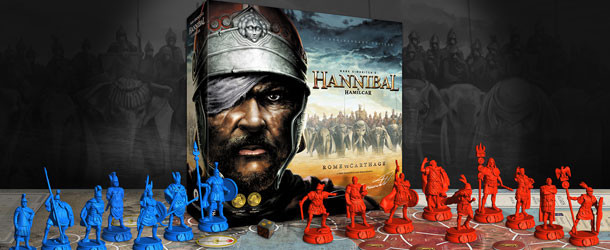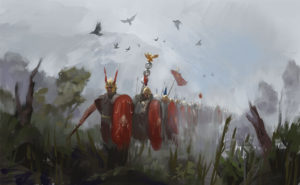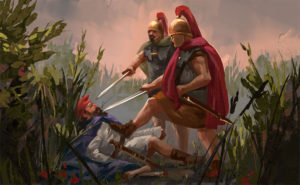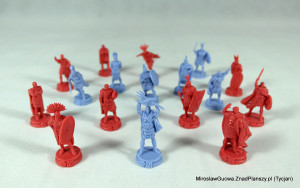Our previous article about Hannibal & Hamilcar: Rome vs Cartage covered the development of "Hamilcar". Today, it’s time for another exciting topic, especially for military enthusiasts - the Roman army of the Hannibal era.
For this matter, PHALANX team called upon the expert help of Dariusz Góralski, a game designer and veteran wargamer, as well as other sources.
Hannibal is a game set in the Second Punic War, and it was very important for our developers to stay true to the knowledge we have of that period of ancient history.
Rome, during the period of 509 - 27 BC was a Republic, and it went through many reforms, including of course, the ones to its military. In the beginning of the fourth century BC, during the rulership of Marcus Furius Camillus (who is sometimes assigned the credit for it), Romans decided to drop the hoplite phalanx system and adopt a more flexible system of a manipular army. This new system was used only until the reforms of Gaius Marius around 100 BC, who introduced the wide utilization of cohorts.
A manipular army was composed of legions (approximately 5,000 men each). The name “manipular” was derived from the fact that the basic military unit (infantry) capable of taking tactical actions was the so-called “manipulus” of 120 men. There were a few different manipuli, in which soldiers were assigned depending somewhat on their age, experience, and social class (wealth). Apart from supporting units, the lightly armored velites armed with distance weapons, such as javelins, and the equite cavalry (consisting of the rich only), there were three main infantry bodies in a legion. The first rank, or “hastate”, were young and inexperienced soldiers who stood on the front lines. The second rank, or “principes”, experienced the fervor of the battle. Finally, the third rank, or “triarii”, were the veterans of advanced age as well as military experience. Additionally, during those times, half of the legions of Rome consisted of soldiers from allied countries (socii) of the confederation.
When we had to apply this knowledge to the game, and deciding how to feature Roman soldiers from a visual point of view, Dariusz helped us with his expertise about ancient uniforms and combat tactics.
The most common troop in the legions was medium infantry: equipped with shields (scutum), Gallic helmets, swords (Greek or Gallic, as the renowned Spanish swords didn’t come into use until after the conquering of New Carthage), two javelins (pilum eminus and pilum comminus), and armor (either the previously mentioned “lorica hamata”, a Greek cuirass that was a different version of thorax, or, most often, an Italian cardiophylax). This is the manner in which maniples of hastati and principes were armed during those wars.
What do you think a roman soldier looked like? Red embroidered tunic? Shiny armor and spaulders? Impenetrable steel shield? Golden helmet? Sometimes! But, fortunately enough for the enemies of Rome at that time, most of the equipment of a legionnaire was self-acquired, especially since it was a requirement in order to join the army.
So what kind of Roman infantryman did we wanted to see depicted on the game tokens? He should be a combination of a typical hastatus and princeps. It seems that those two didn’t differ much, apart from their age and battle experience. To be more specific, the infantryman would be garbed in a white tunic girded with a cingulum belt. He would have a Celtic Montefortino helmet decorated with a plume and some feathers. He would be equipped with phylax armor, a sword (let it be a gladius), and two pilum javelins (as described by Polybius), but most importantly, he would be protected by a 1.2-meter long and 0.8-meter wide oval shield. This shield was the most vital part of the Roman infantryman’s equipment. It allowed the infantryman to stay safe in the army formation and, having thrown both pila, to attack foes from its cover with a sword.
We need to note that the average Italian citizen of that time was slightly over 1.6 meters tall (which is about the height of today’s typical elderly resident of the Italian countryside). The scutum shield, with its iron shield boss (umbo) located in its center, practically covered the whole soldier while he was marching in a bent position. Only the plume, the feathers, and the cover on the left foot were visible. It must have been quite a view!
Last, but not least, a note about the Legions. In order to continuously enlarge the domains of the Eternal City, four legions were enrolled each year. However, during the Punic Wars, more and more men were needed, and in the second war 25 additional legions were raised! Even though this took a huge toll on Rome and caused the strength of its army to deteriorate, it still managed to maintain an army of up to 700,000 men and defeat the armies of Carthage. Which, by the way, will be the topic of the next article, so stay tuned: in the next article, we will learn more about the Carthaginian Army.
See also:














